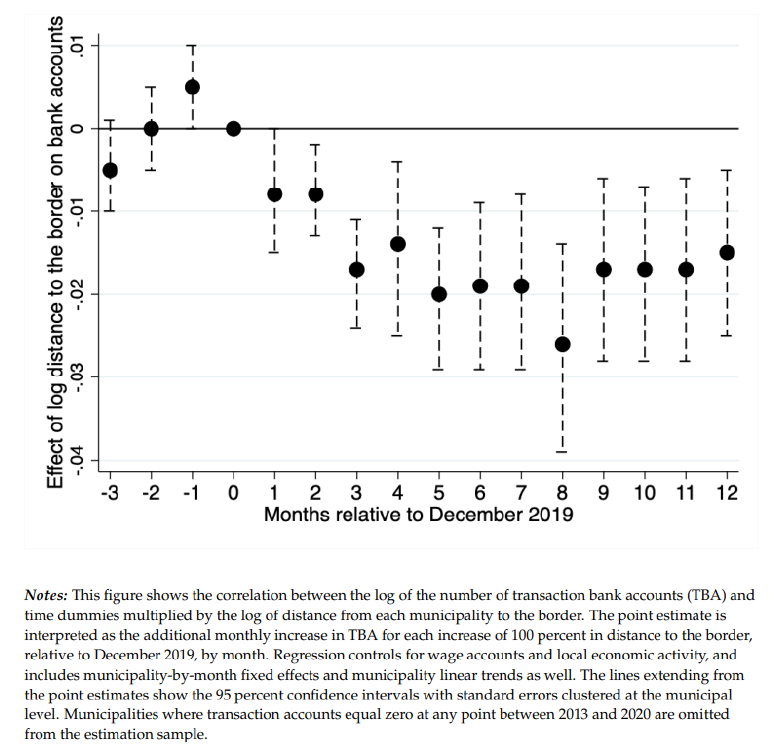 Unsplash
Unsplash
This blog is a biweekly feature highlighting recent working papers from around the World Bank Group that were published in the World Bank’s Policy Research Working Paper Series. This entry introduces five papers published from May 16 to May 31, 2022, on various topics, including migration, public private partnerships (PPPs), vaccine equity, remittances, and land titling.
The first two papers we introduce take us to South America. In Policy Preferences in Response to Large Migration Inflows, William Allen and coauthors address the preferred policy responses of host country residents to large migration inflows and the extent to which these preferences are driven by contact with migrants. In Managing the Fiscal Risks Wrought by PPPs : A Simple Framework and Some Lessons from Chile, Eduardo Engel and coauthors develop a conceptual framework to assess whether and how public-private partnerships shift risks to concessionaires and financiers.
-
In Colombia, Policy Preferences in Response to Large Migration Inflows explores the preferred policy responses of Colombia’s residents to Venezuelan immigration, which is one of the largest global migrations. The authors address whether these preferences are driven by different priorities (for example, economic or humanitarian priorities) and meaningful social contact. Results reveal support for the options of conditional access to the labor market (for example, only in certain occupations) or full free access to the alternative of no access, for unrestricted location choices and access to public services, as well as conditional rights to family reunification (for example, only if immigrants are able to support their dependents). Respondents also support the use of numerical limits and limiting the length of residency permits. The results also show that those who put more emphasis on economic priorities relative to humanitarian ones, and those who see the situation in Colombia as mainly an economic problem, tend to support policies that are more restrictive. Meanwhile, people who report having higher levels of social contact with Venezuelans also hold preferences for less restrictive policies when it comes to labor market access and family reunification.
-
In the early 1990s, Chile launched a massive program of PPP infrastructure investment, leading to substantial additions and improvements of the existing infrastructure. In Managing the Fiscal Risks Wrought by PPPs : A Simple Framework and Some Lessons from Chile the coauthors develop a conceptual framework to assess if and how PPPs shift risks to concessionaires and financier and apply it to the Chilean case. The paper identifies renegotiations as the major source of fiscal risk, which involved additional investments, increasing the cost by about one-third over the original project cost estimates. The 2010 law reform on PPPs introduced changes to the renegotiations regime and started the routine use of variable term contracts. Using contractual data, the analysis finds evidence suggesting that renegotiations fell dramatically. The paper also calculates the realized internal rates of return for 50 highway and airport PPPs, using cash flow data for the entire PPP program, started in 1991. The average internal rate of return is 6.8 percent, with averages of 9.1 and 3.1 percent for fixed and variable term PPPs, respectively. The returns show a large dispersion, suggesting that infrastructure projects are intrinsically risky and private participation entails significant risk shifting from the budget to concessionaires and financiers.
The next two papers we introduce deal with topics related to the COVID-19 pandemic. In Financing Vaccine Equity : Funding for Day-Zero of the Next Pandemic, Ruchir Agarwal and Tristan Reed explore the delay in vaccine deliveries to low- and middle-income countries and the potential policy implications of this. In Neither by Land nor by Sea : The Rise of Electronic Remittances during COVID-19, Lelys Dinarte-Diaz and coauthors explore the effect that the COVID-19 economic collapse had on remittances.
-
Financing Vaccine Equity: Funding for Day-Zero of the Next Pandemic finds that 60–75 percent of the delay in vaccine deliveries to low- and middle-income countries is attributable to signing purchase agreements later in these countries compared to high-income countries— putting them further behind in the delivery line. The paper argues that a pandemic Advance Commitment Facility with access to a credit line on day-zero of the next pandemic could allow low- and middle-income countries to secure orders earlier, ensuring a much faster and equitable global response than during COVD-19. The paper also outlines four options for a financier to absorb some or all the risk associated with the credit line and discusses how the credit would complement other proposals.
-
As a result of the COVID-19 pandemic and subsequent the economic downturn, remittances were expected to decrease considerably. However, formal remittances to many developing countries increased considerably. Neither by Land nor by Sea: The Rise of Electronic Remittances during COVID-19 uses data from Mexico to explore how the remittance channels change. Findings suggest that a sudden acceleration in the formalization of remittances partly explains the increase in recorded remittances observed in several developing countries during the first period of the COVID-19 pandemic. This stemmed from a prohibitive increase in the costs of sending informal remittances due to mobility restrictions imposed to control contagion. The paper shows that the increase in formal remittances was driven by municipalities closer to a US border crossing that had been more likely to receive informal remittances before March 2020. Consistent with this hypothesis, these areas also experienced a disproportionate increase in bank account transactions during this period. These accounts were probably opened to receive formal remittances via electronic transfer that would have come through informal channels prior to the pandemic.
Figure 1: Effects of distance to the border on transaction bank accounts

For the final paper we travel to Lesotho to learn about the impacts of urban land titling. In How Urban Land Titling and Registry Reform Affect Land and Credit Markets : Evidence from Lesotho, Klaus Deininger and Daniel Ayalew Ali draw on complete registry data for 1981–2019, supplemented by satellite imagery, to analyze the impacts of urban land titling for some 40,000 grid cells in Lesotho. The paper documents medium-term impacts on land sale and mortgage market activity and women’s participation in these markets. Although titling was instrumental in ensuring the effectiveness of an earlier legal reform that allowed women to be co-owners of land, the credit and land market effects are not due to titling but rather to changes in policy to reduce the transaction cost of registering land that took effect just before titling started. Downward shifts in the time required to register transactions support this interpretation.
The share of registered parcels with at least one female co-owner (see Figure 2 below) changed only slightly after passage of the landmark 2006 Legal Capacity of Married Persons Act (LCMPA), which, for the first time in Lesotho’s history, allows married women to hold and register land rights in their names and provides supportive regulations. The LCMPA alone had no impact on female co-ownership of land until the 2010 Land Act made co-ownership the default option for common-law marriages, an awareness campaign had been launched, and procedures for systematic initial registration were designed to put such rights into practice.
Figure 2: Non-parametric Regression of Initial Registrations with One or More Female Co-owners, Percent
The following are other interesting papers published in the second half of May. Please make sure to read them as well.
-
Intensity-Based Rebating of Emission Pricing Revenues (Böhringer,Christoph,Fischer,Carolyn,Rivers,Nicholas)
-
The Demand for Digital and Complementary Skills in Southeast Asia (Cunningham,Wendy,Moroz,Harry Edmund,Muller,Noel,Solatorio,Aivin Vicquierra)
-
Spatial Development and Mobility Frictions in Latin America : Theory-Based Empirical Evidence (Conte,Bruno,Ianchovichina,Elena)
-
Trade Policy and Exporters’ Resilience : Evidence from Indonesia (Cali,Massimiliano,Ghose,Devaki,Montfaucon,Angella Faith Lapukeni,Ruta,Michele
-
Trade, Transport, and Territorial Development (Dasgupta,Kunal,Grover,Arti Goswami)
-
Is Inequality Systematically Underestimated in Sub-Saharan Africa A Proposal to Overcome the Problem (Clementi,Fabio,Fabiani,Michele,Molini,Vasco,Schettino,Francesco)
-
Trucking Costs and the Margins of Internal Trade : Evidence from a Trucking Portal in India (Lall,Somik V.,Sinha Roy,Sutirtha,Shilpi,Forhad J.)
-
Inequality and Security in the Aftermath of Internal Population Displacement Shocks : Evidence from Nigeria (Ludolph,Lars,Šedová,Barbora,Talevi,Marta)
-
The Effects of Internally Displaced Peoples on Consumption and Inequality in Mali (Foltz,Jeremy David,Shibuya,Sakina)
-
Refugees, Diversity and Conflict in Sub-Saharan Africa (Bertinelli,Luisito,Comertpay,Rana,Maystadt,Jean-François)
-
Measuring What Matters : Principles for a Balanced Data Suite That Prioritizes Problem-Solving and Learning (Bridges,Kate,Woolcock,Michael)
-
Firm-Level Input Distortion in Indian States (Chaurey,Ritam,Manghnani,Ruchita,Perego,Viviana Maria Eugenia,Sharma,Siddharth)
-
How Binding Is Supervisory Guidance Evidence from the European Calendar Provisioning (Fiordelisi,Franco,Lattanzio,Gabriele,Mare,Davide Salvatore)
-
Mobility and Resilience : A Global Assessment of Flood Impacts on Road Transportation Networks (He,Yiyi,Maruyama Rentschler,Jun Erik,Avner,Paolo,Gao,Jianxi,Yue,Xiangyu,Radke,John)
-
Normative Indicators Combining Poverty and Mortality : A Survey (Decerf,Benoit Marie A)
-
Two Heads Are Better Than One : Agricultural Production and Investment in Côte d’Ivoire (Donald,Aletheia Amalia,Goldstein,Markus P.,Rouanet,Lea Marie)
-
Livelihood Impacts of Refugees on Host Communities : Evidence from Ethiopia (Walelign,Solomon Zena,Wang Sonne,Soazic Elise,Seshan,Ganesh Kumar)
-
Prospects for Markets for Internationally Transferred Mitigation Outcomes under the Paris Agreement (Strand,Jon)
-
Qualitative Analysis at Scale : An Application to Aspirations in Cox's Bazaar, Bangladesh (Ashwin,Julian,Rao,Vijayendra,Biradavolu,Monica Rao,Haque,Arshia,Khan,Afsana Iffat,Krishnan,Nandini,Nagy,Peer Sebastian)




Join the Conversation